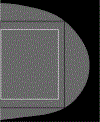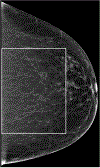Generalized breast density metrics
- PMID: 30523909
- PMCID: PMC7034052
- DOI: 10.1088/1361-6560/aaf307
Generalized breast density metrics
Abstract
Mammograms represent data that can inform future risk of breast cancer. Data from two case-control study populations were analyzed. Population 1 included women (N = 180 age matched case-control pairs) with mammograms acquired with one indirect x-ray conversion mammography unit. Population 2 included women (N = 319 age matched case-control pairs) with mammograms acquired from 6 direct x-ray conversion units. The Fourier domain was decomposed into n concentric rings (radial spatial frequency bands). The power in each ring was summarized giving a set of measures. We investigated images in raw, for presentation (processed) and calibrated representations and made comparison with the percentage of breast density (BD) determined with the operator assisted Cumulus method. Breast cancer associations were evaluated with conditional logistic regression, adjusted for body mass index and ethnicity. Odds ratios (ORs), per standard deviation increase derived from the respective breast density distributions and 95% confidence intervals (CIs) were estimated. A measure from a lower radial frequency ring, corresponding 0.083-0.166 cycles mm-1 and BD had significant associations with risk in both populations. In Population 1, the Fourier measure produced significant associations in each representation: OR = 1.76 (1.33, 2.32) for raw; OR = 1.43 (1.09, 1.87) for processed; and OR = 1.68 (1.26, 2.25) for calibrated. BD also provided significant associations in Population 1: OR = 1.72 (1.27, 2.33). In Population 2, the Fourier measure produced significant associations for each representation as well: OR = 1.47 (1.19, 1.80) for raw; OR = 1.38 (1.15, 1.67) for processed; and OR = 1.42 (1.15, 1.75) for calibrated. BD provided significant associations in Population 2: OR = 1.43 (1.17, 1.76). Other coincident spectral regions were also predictive of case-control status. In sum, generalized breast density measures were significantly associated with breast cancer in both FFDM technologies.
Conflict of interest statement
Conflicts of interest
The authors have patents and pending patent applications in related work.
Figures









References
-
- McCormack VA, and dos Santos Silva I, “Breast density and parenchymal patterns as markers of breast cancer risk: a meta-analysis,” Cancer Epidemiol Biomarkers Prev, vol. 15, no. 6, pp. 1159–69, June, 2006. - PubMed
-
- Huo CW, Chew GL, Britt KL, Ingman WV, Henderson MA, Hopper JL, and Thompson EW, “Mammographic density-a review on the current understanding of its association with breast cancer,” Breast Cancer Res Treat, vol. 144, no. 3, pp. 479–502, April, 2014. - PubMed
-
- Pettersson A, Graff RE, Ursin G, Santos Silva ID, McCormack V, Baglietto L, Vachon C, Bakker MF, Giles GG, Chia KS, Czene K, Eriksson L, Hall P, Hartman M, Warren RM, Hislop G, Chiarelli AM, Hopper JL, Krishnan K, Li J, Li Q, Pagano I, Rosner BA, Wong CS, Scott C, Stone J, Maskarinec G, Boyd NF, van Gils CH, and Tamimi RM, “Mammographic density phenotypes and risk of breast cancer: a meta-analysis,” J Natl Cancer Inst, vol. 106, no. 5, May, 2014. - PMC - PubMed
-
- Brandt KR, Scott CG, Ma L, Mahmoudzadeh AP, Jensen MR, Whaley DH, Wu FF, Malkov S, Hruska CB, Norman AD, Heine J, Shepherd J, Pankratz VS, Kerlikowske K, and Vachon CM, “Comparison of Clinical and Automated Breast Density Measurements: Implications for Risk Prediction and Supplemental Screening,” Radiology, vol. 279, no. 3, pp. 710–9, 2016. - PMC - PubMed
Publication types
MeSH terms
Grants and funding
LinkOut - more resources
Full Text Sources
Medical
